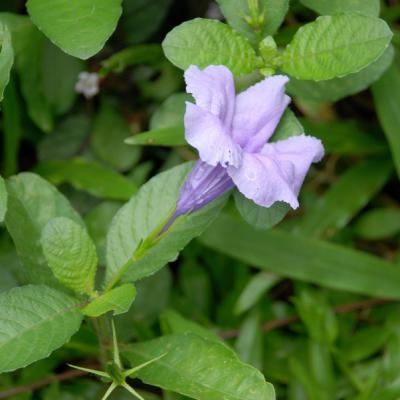Acanthaceae-Ruellia-tuberosa
Classification
- Botanical Family : Acanthaceae
- Genus : Ruellia
- Epithet : tuberosa
- German Family Name: Bärenklaugewächse
- English Name: Minnieroot
- Thai Name: ต้อยติ่ง
- Thai Phonetic: toi ting
- Author: L.
- Height: 0.30
Water Requirements
Plant Type
Light Requirements
Cultivation
Ruellia tuberosa is a plant that is found commonly in the wild nature. It is rarely planted in the garden. But the pretty lilac-colored flowers and the low high of the plant (about 30 cm high) makes it a good ground cover.
The spindle-shaped tubers are finger-like.
Ruellia tuberosa flowering at the beginning of the rainy season. It grows best in full sun or light shade.
The ripe seed pods with 7-8 seeds to pop up when they come into contact with water.
Propagation: Seeds or Cuttings
Cuttings (which should be about 10 cm long) should be instantly plant into moist soil. Use strong stems.
Ruellia tuberosa ist eine Pflanze, die man üblicherweise wild in der Natur antrifft. Sie wird selten im Garten angepflanzt. Aber die hübschen fliederfarbenen Blüten und der niedrige Wuchs der Pflanze (ca. 30 cm hoch) lässt sie zu einem guten Bodendecker werden.
Die spindelförmigen Wurzelknollen sind fingerähnlich .
Ruellia tuberosa blüht zu Beginn der Regenzeit. Sie gedeiht am besten in voller Sonne oder lichtem Halbschatten.
Die reifen Samenschoten mit 7 bis 8 Samenkörnern springen auf, wenn sie mit Wasser in Berührung kommen.
Vermehrung: durch Aussaat oder Stecklinge
Bei Aussaat die Samen einige Stunden in handwarmen Wasser anquellen lassen.
Stecklingen nach dem Abschnitt (diese sollten ca. 10 cm lang sein) sofort in feuchte Erde verpflanzen. Möglichst schon kräftige Stengel verwenden.
Origin
Miscelaneous
Ethnomedical uses
The ethnomedical information is provided for general information only, it is not intended as guidance for medicinal use.
Roots and leaves are used.
In animal models, this plant has anti-inflammatory properties. (1)
Ruellia tuberosa has an antioxidant activity. (2)
It is also used as a natural dye for textiles. (3)
(1) Alam, M. Ashraful; Subhan, Nusrat; Awal, M. Abdul; Alam, M. Shohidul; Sarder, Mokaddez; Nahar, Lutfun; Sarker, Satyajit D. (2009). "Antinociceptive and anti-inflammatory properties of Ruellia tuberosa". Pharmaceutical Biology 47 (3): 209 http://informahealthcare.com/doi/abs/10.1080/13880200802434575
(2) http://www.sciencedirect.com/science/article/pii/S0308814604008027
(3) Effect of Chitosan and Mordants on Dyeability of Cotton Fabrics with Ruellia tuberosa Linn.
Piyaporn Kampeerapappun, Trongsu Phattararittigul, Sutida Jittrong, and Dararat Kullachod
Division of Textile Chemical Engineering, Faculty of Textile Industries, Rajamangala University of Technology Krungthep, Bangkok, 10120, Thailand Chiang Mai J. Sci. 2010; 38(1) : 95-104 http://it.science.cmu.ac.th/ejournal/journalDetail.php?journal_id=477
Volksmedizinische Verwendung
Die Information über volksmedizinische Verwendung ist nur zur allgemeinen Information und nicht als medizinischer Ratgeber zu betrachten.
Verwendet werden Wurzeln und Blätter.
In Tierversuchen wurden von Ruellia tuberosa entzündungshemmende Eigenschaften nachgewiesen. (1)
Ruellia tuberosa hat eine starke antioxidative Wirkung. (2)
Es wird auch als natürlicher Farbstoff für Textilien verwendet. (3)
(1) Alam, M. Ashraful; Subhan, Nusrat; Awal, M. Abdul; Alam, M. Shohidul; Sarder, Mokaddez; Nahar, Lutfun; Sarker, Satyajit D. (2009). "Antinociceptive and anti-inflammatory properties of Ruellia tuberosa". Pharmaceutical Biology 47 (3): 209 http://informahealthcare.com/doi/abs/10.1080/13880200802434575
(2) http://www.sciencedirect.com/science/article/pii/S0308814604008027
(3) Effect of Chitosan and Mordants on Dyeability of Cotton Fabrics with Ruellia tuberosa Linn.
Piyaporn Kampeerapappun*, Trongsu Phattararittigul, Sutida Jittrong, and Dararat Kullachod
Division of Textile Chemical Engineering, Faculty of Textile Industries, Rajamangala University of Technology
Krungthep, Bangkok, 10120, Thailand Chiang Mai J. Sci. 2010; 38(1) : 95-104 http://it.science.cmu.ac.th/ejournal/journalDetail.php?journal_id=477

